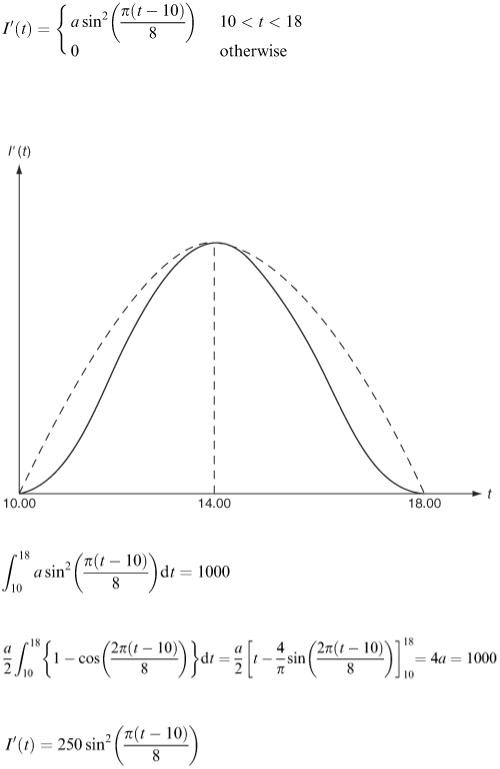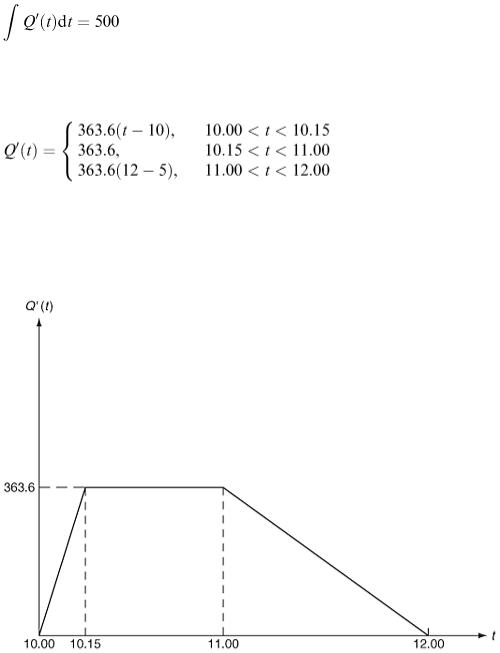
- •Preface
- •1.1 Introduction
- •1.2 Models and modelling
- •1.3 The learning process for mathematical modelling
- •Summary
- •Aims and objectives
- •2.1 Introduction
- •2.2 Examples
- •2.3 Further examples
- •Appendix 1
- •Appendix 2
- •Aims and objectives
- •3.1 Introduction
- •3.2 Definitions and terminology
- •3.3 Methodology and modelling flow chart
- •3.4 The methodology in practice
- •Background to the problem
- •Summary
- •Aims and objectives
- •4.1 Introduction
- •4.2 Listing factors
- •4.3 Making assumptions
- •4.4 Types of behaviour
- •4.5 Translating into mathematics
- •4.6 Choosing mathematical functions
- •Case 1
- •Case 2
- •Case 3
- •4.7 Relative sizes of terms
- •4.8 Units
- •4.9 Dimensions
- •4.10 Dimensional analysis
- •Summary
- •Aims and objectives
- •5.1 Introduction
- •5.2 First-order linear difference equations
- •5.3 Tending to a limit
- •5.4 More than one variable
- •5.5 Matrix models
- •5.6 Non-linear models and chaos
- •5.7 Using spreadsheets
- •Aims and objectives
- •6.1 Introduction
- •6.2 First order, one variable
- •6.3 Second order, one variable
- •6.4 Second order, two variables (uncoupled)
- •6.5 Simultaneous coupled differential equations
- •Summary
- •Aims and objectives
- •7.1 Introduction
- •7.2 Modelling random variables
- •7.3 Generating random numbers
- •7.4 Simulations
- •7.5 Using simulation models
- •7.6 Packages and simulation languages
- •Summary
- •Aims and objectives
- •8.1 Introduction
- •8.2 Data collection
- •8.3 Empirical models
- •8.4 Estimating parameters
- •8.5 Errors and accuracy
- •8.6 Testing models
- •Summary
- •Aims and objectives
- •9.1 Introduction
- •9.2 Driving speeds
- •Context
- •Problem statement
- •Formulate a mathematical model
- •Rewritten problem statement
- •Obtain the mathematical solution
- •9.3 Tax on cigarette smoking
- •Context
- •Problem statement
- •Formulate a mathematical model
- •Obtain the mathematical solution
- •9.4 Shopping trips
- •Context
- •Problem statement
- •Formulate a mathematical model
- •Obtain the mathematical solution
- •Interpret the mathematical solution
- •Using the model
- •9.5 Disk pressing
- •Context
- •Problem statement
- •Formulate a mathematical model
- •Obtain the mathematical solution
- •Interpret the mathematical solution
- •Further thoughts
- •9.6 Gutter
- •Context and problem statement
- •Formulate a mathematical model
- •Obtain the mathematical solution
- •9.7 Turf
- •Context
- •Problem statement
- •Formulate a mathematical model
- •Obtain the mathematical solution
- •Interpret the solution
- •9.8 Parachute jump
- •Context and problem statement
- •Formulate a mathematical model
- •Obtain the mathematical solution
- •9.9 On the buses
- •Context
- •Problem statement
- •Formulate a mathematical model
- •Obtain the mathematical solution
- •9.10 Further battles
- •Discrete deterministic model
- •Discrete stochastic model
- •Comparing the models
- •9.11 Snooker
- •Context
- •Problem statement
- •Formulate a mathematical model
- •Obtain the mathematical solution
- •Interpret the mathematical solution
- •9.12 Further models
- •Mileage
- •Heads or tails
- •Picture hanging
- •Motorway
- •Vehicle-merging delay at a junction
- •Family names
- •Estimating animal populations
- •Simulation of population growth
- •Needle crystals
- •Car parking
- •Overhead projector
- •Sheep farming
- •Aims and objectives
- •10.1 Introduction
- •10.2 Report writing
- •Preliminary
- •Main body
- •Appendices
- •Summary
- •General remarks
- •10.3 A specimen report
- •Contents
- •1 PRELIMINARY SECTIONS
- •1.1 Summary and conclusions
- •1.2 Glossary
- •2 MAIN SECTIONS
- •2.1 Problem statement
- •2.2 Assumptions
- •2.3 Individual testing
- •2.4 Single-stage procedure
- •2.5 Two-stage procedure
- •2.6 Results
- •2.7 Regular section procedures
- •2.8 Conclusions
- •3 APPENDICES
- •3.1 Possible extensions
- •3.2 Mathematical analysis
- •10.4 Presentation
- •Preparation
- •Giving the presentation
- •Bibliography
- •Solutions to Exercises
- •Chapter 2
- •Example 2.2 – Double wiper overlap problem
- •Chapter 4
- •Chapter 5
- •Chapter 6
- •Chapter 8
- •Index

(Check that this satisfies the required conditions.)
We now need to calculate the parameter a so that the total sales over the whole day amount to 1000 cones. This is easily done by integration
Figure 4.14
i.e.
So finally our model is
This means that at the height of the day at 2.00 pm we are selling at the rate of 250 cones every hour, i.e. four cones every minute.
Case 3
The jumble sale problem is somewhat different. This time we are given that 500 customers are expected; many of them will be waiting for the doors to open at the start. Suppose that the sale runs

from 10.00 am until 12.00 noon. We shall need most helpers at the start to deal with the rush. Later, as many of the most sought-after items have been sold, demand will slacken off. Suppose that we are
interested in the rate of entry of customers. Denote this by Q ′( t ) where t is the time in hours. Then again, as we know the total to be 500, there is the relation
(4.1)
In Figure 4.15, we speculate on the inflow. We have indicated that Q ′( t ) is very high at the start, remains constant for the rest of the first hour and then decreases steadily to zero at the end.
As before, Q ′( t ) requires more than one equation for its specification:
The factor 363.6 is calculated from equation (4.1) above. Modelling is an activity where we want to represent trends and relations between quantities, and usually at this stage we do not want a parameter quoted to several decimal places. This means that the slightly clumsy value of 363.6 might well be replaced by 360.0, even though the customer total would then be not quite equal to 500. We do not have to use the form of Q ′( t ) just derived. You may wish to model the form in Figure 4.16.
Figure 4.15

Figure 4.16
This form suggests a mathematical representation at exp(− bt ). There are now two parameters to fix. We have the tailing off that we want, but we have to realise that Q ′ will never actually reach zero as t increases in this model. This alternative is left for you to finish, not forgetting that the time range is 10.00 < t < 12.00 and also that the integral relation holds:
Exercises
The air temperature just above the ground at a particular point on the Earth often varies in a
4.11periodic manner over a 24 h cycle. The daily mean value also varies with the seasons, i.e. over an annual cycle. If the time t is measured in hours what would be an appropriate mathematical model for the temperature as a function of t ?
In Example 2.4 (‘price war’), we assumed that the sales of both petrol stations would increase if
4.12they dropped their prices, or in other words the total petrol sales in their area would increase. Suppose instead that the local sales volume is constant so that the two garages are competing for larger shares of the same market. Suppose also
that each garage's daily sales figure is inversely proportional to the price at which they sell. Obtain mathematical expressions for each garage's daily sales in terms of their selling prices x and y.
For a certain type of tree the rate of growth is slow in winter and greatest during the summer
4.13months. The rate of growth also lessens every year from a maximum in the first year until there is virtually no growth at all after 10 years. What would be a suitable mathematical model for the rate of growth?
